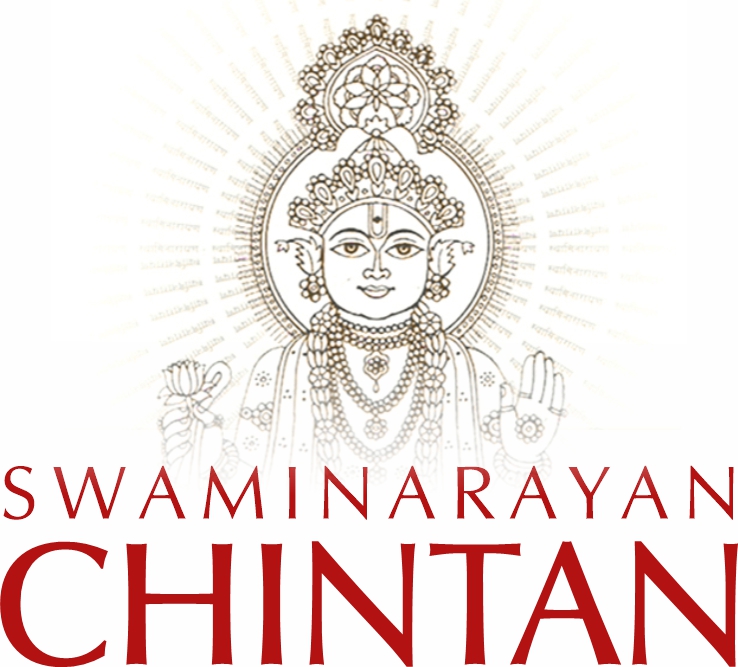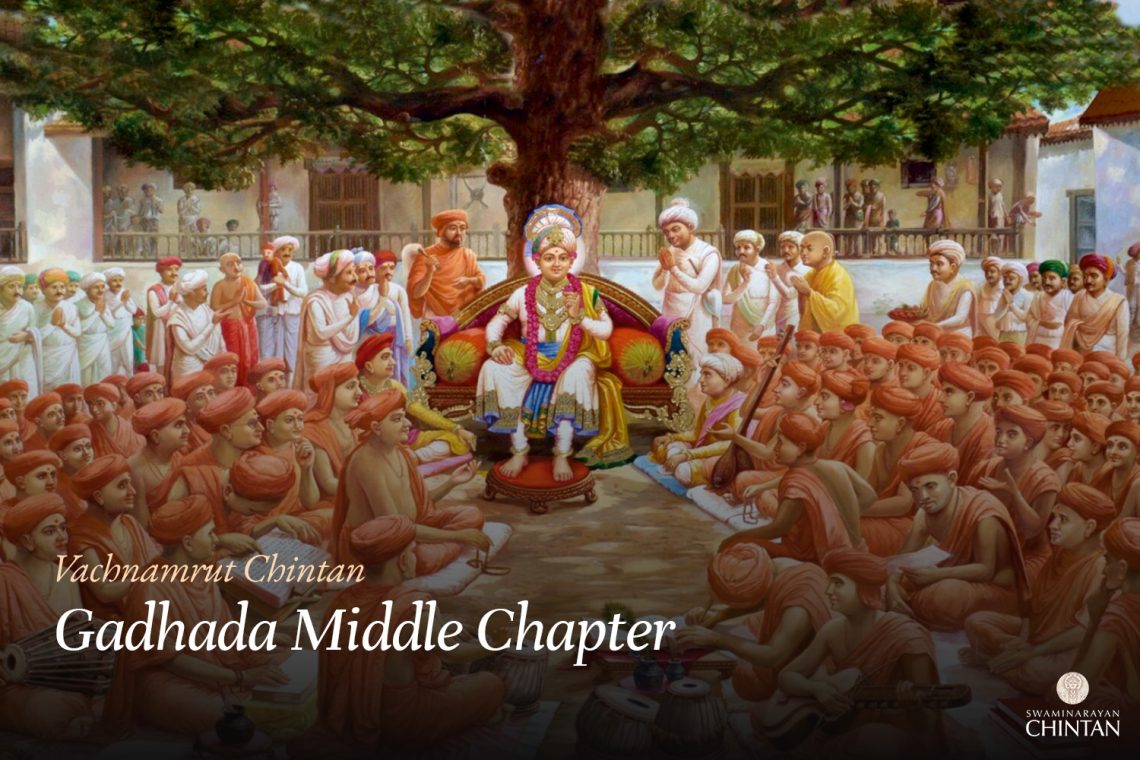Central Insights: Key Points: Explanation: In this Vachanamrut, Shreeji Maharaj kindly advises devotees that a devotee of Bhagwan should never do anything that displeases Bhagwan or His devotees. Instead, one should do what pleases them and not prioritize anything that obstructs devotion. Such obstacles should either be abandoned or regarded…
Browsing CategoryVachanamrut Chintan
GM-25 The Renunciate with Desires and the Householder without Desires
Central Insights: Key Points: Explanation: In this Vachanamrut, Maharaj poses a question to the Paramhansas: one person is a renunciate with intense desires for sense pleasures, and the other is a householder without any desires. Both outwardly follow the practices of their respective Vartman (sacred vows). Maharaj asks what kind…
GM-24 Firmness In Sankhya and Yog
Central Insights: Key Points: Explanation: In this Vachanamrut, Muktanand Swami asks a question: “Is there any distraction that can hinder a devotee who has unwavering faith in Bhagwan?” In response, Maharaj explains that there are two types of steadfastness: Yog-oriented steadfastness and Sankhya-oriented steadfastness. Yog-oriented steadfastness is the determination that…
GM-23 Heat and frost
Central Insights: Key Points: Explanation: In this Vachanamrut, Maharaj states that upon contemplating the form of the mind, He found that the mind is not distinct from the jiva. It is merely an offshoot, like a ray of the jiva. Maharaj explains that the form of the mind is like…
GM-22 Two Armies The Installation Of Nar-Narayan Dev
Central Insights: Key Points: Explanation: In this Vachanamrut, Maharaj begins with words of compassion. This is a Vachanamrut meant to help establish a firm goal. Maharaj explains that when two armies are ready to fight, with their flags raised opposite each other, each army is determined to tear down the…
GM-21 The Main Principle
Central Insights: Key Points: Explanation: In this Vachanamrut, Shreeji Maharaj emphasizes that all the scriptures and texts explaining the means to attain Kalyan have been carefully studied. The central tenet across all these texts is that Bhagwan is the ultimate Karta-Harta (doer and undoer) of the entire universe. Moreover, Shreeji…
GM-20 How Does a Samadhi-Nishta Gain Increased Strength in Gyan-Shakti and the Power of the Senses?
Central Insights: Key Points: Explanation: In this Vachanamrut, the topic of discussion is whether individuals in samadhi experience an increase in knowledge and the strength of the body and senses. The santo were unable to provide a definitive answer, so Maharaj Himself clarified: When a jiva (soul) enters samadhi, the…
GM-19 Writing Out of Despair After Listening to a Dry Vedanta Text
Central Insights: Key Points: Explanation: In this Vachanamrut, Maharaj is deeply saddened, and tears begin to fall from His lotus eyes. Maharaj says, “Today, I listened to the scriptures of a shushkajnani just to understand their doctrine, and it has caused me great distress. This is because, through such knowledge,…
GM-18 The Atheist and the Dry Vedantist
Central Insights: Key Points: Explanation: Maharaj says, “I have reflected on all aspects, and I have realized that among all the forms of kusang (evil association) in this world, the most dangerous is the company of someone who lacks devotion to Bhagwan and does not believe that Bhagwan is the…
GM-17 Whether God’s Form Contains Elements? And the Concept of Sthitapragna
Central Insights: Key Points: Explanation: In this Vachanamrut, Maharaj asked the munis a question: Some devotees believe that God’s form includes the 24 elements of Maya, while others believe that God’s form is purely spiritual (chaitanyamay) and free from these elements. Among these two types of devotees, whose understanding is…
GM-16 Swaroopnishtha and Dharmanishtha
Central Insights: Key Points: Explanation: In this Vachanamrut, Muktanand Swami raised a question: There are two types of steadfastness—one is like Swaroopnishtha (steadfastness in God’s form), which Arjun exemplified, and the other is like Dharmanishtha (steadfastness in Dharma), which was seen in King Yudhishthir. Often, when one holds firm to…
GM-15 On Maintaining Enmity Towards One’s Nature
Central Insights: Key Points: Explanation: This Vachanamrut emphasizes maintaining enmity towards one’s swabhav. Enmity towards one’s own swabhav is the primary cause for its eradication. Mere austerities and fasting cannot uproot the enemies such as lust, anger, etc. There are many ascetics and renunciates, as seen in both scriptures and…
GM-14 On Nirvikalp Samadhi
Central Insights: Key Points: Explanation: In this Vachanamrut, Muktanand Swami asked Maharaj whether a Sant who attains oneness with Bhagwan does so through Samadhi or if there is another method? In response, Maharaj first explained the definition of Tadatmakpanu and then described the means to achieve it, followed by its…
GM-13 The Supreme Swarup Within The Divine Light
Central Insights: Key Point: Commentary: This Vachanamrut is referred to as the “Radiance Vachanamrut.” The word tej (Radiance) can mean both light and influence. Here, the discussion focuses on the radiance, or rather, the influence of the murti. What is the glory or the influence of the murti? That is…
GM-12 The Art Of Ruling
Central Insights: Key Points: Explanation: This Vachanamrut is about Rajneeti (politics). It explains how to assume control of power, the actions and reactions necessary to gain power, and the means to ensure that once power is obtained, it remains securely in one’s hands for the long term. This entire process…
GM–11 All Karmas Becoming A Form Of Bhakti
Central Insights: Key Point: Explanation: In this Vachanamrut, Maharaj states that upon hearing scriptures such as the Mahabharat, Ramayan, Puranas, or Smriti texts, some souls understand them only in relation to dharma (morality), artha (worldly prosperity), and kam (worldly desires). That is, they believe the scriptures teach how to perform…
GM-10 Safeguard the Faith in God like safeguarding Foetus
Central Insights: Key Points: Explanation: In the first part of this Vachanamrut, Maharaj explains the importance of nurturing the “seed” that leads to liberation, likening it to the care one must provide to an embryo. Just as an embryo has no defined form initially but, when properly nurtured, grows into…
GM-09 Firm Faith in God’s Form; Believing Almighty God to be like Other Incarnations Is his Insult
Central Insights: Key Point: Explanation: This Vachanamrut emphasizes Swaroop Nishtha—firm faith in God’s divine form. By the word Swaroop, Maharaj refers to the murti (divine form) of God. The form of God is eternal, divine, and with attributes. God’s form is such that it possesses countless dimensions and attributes. Among…
GM-08 The Importance of Ekadashi, Gyan Yagna, and Antardrushti
Central Insights: Key Points: Explanation: In this Vachanamrut, Maharaj narrates the story from the Puranas regarding the origin of Ekadashi. The son of Nadijangh, Murdanav, performed intense austerities and received a boon from Brahma that he would not be slain by any being created by him. He also could not…
GM-07 The Condition of the Poor
Central Insights: Key Points: Explanation: In this Vachanamrut, Muktanand Swami asked Maharaj, “A devotee of Bhagwan is mindful not to possess any nature that hinders his worship of Bhagwan, yet some inappropriate nature still remains. What is the reason for this? Despite having the desire to eradicate internal distortions, which…
GM-06 The Concept of Drafts and the Nature of the Mind
Central Insights: Key Points: Explanation: In this Vachanamrut, Shreeji Maharaj first asked the junior Santo about the perspective of some people in the world who, like barbarians, claim there is no difference between the water of the holy Gangas and any other water, that the sacred Shaligram (a stone form…

